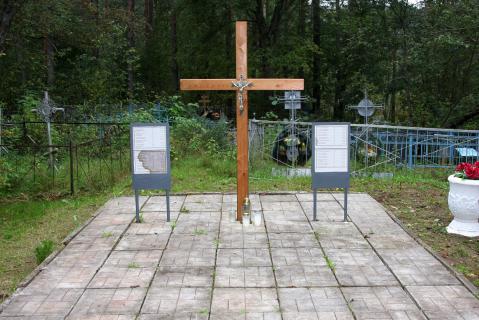Polish prisoners of war at the Ostashkovo POW camp who died of natural causes in 1939-1940 were buried at a graveyard near Troeruchitsa village (today the Sorozhskoe settlement). Local historian B.F. Karpov remembers that the dead were buried in wooden boxes each containing two bodies. By the early 1990s one Polish grave had survived at the Troeruchitsa graveyard. Karpov placed a cross there with a metal nameplate listing 41 surnames.
In the early 2000s the dilapidated cross was replaced by staff from the Mednoe Memorial Complex [69-04]. The new cross was flanked by two boards listing 41 individuals who died in the Ostashkovo camp between September 1939 and May 1940. The information was based on reports by camp commandant P.K. Borisovets, preserved in the Russian State Military Archive. In 1989 Karpov showed the location of the burials to the first delegation of relatives of the Polish POWs. The first Service for the Dead was then held in the Troeruchitsa graveyard.
| Date | Nature of ceremonies | Organiser or responsible person | Participants | Frequency |
|---|---|---|---|---|
|
2-3 September
|
Day of Remembrance and Sorrow
|
Polish delegation
|
delegations from Poland and Polish embassy in Moscow, representatives of the Mednoe Memorial Complex
|
Annual Event
|
| State of burials | Area | Boundaries | Other sites in same area |
|---|---|---|---|
|
a grave-marker has been placed on one of the surviving graves
|
not determined
|
not delineated
|
Early 20th-century church of the Mother of God, Troeruchitsa village (protected since 1999)
|
[ original texts and hyperlinks ]
Report from P.K//. Borisovets [commandant of the Ostashkovo camp], to P.K. Soprunenko about the inmates, regime and security conditions of the Polish prisoners of war throughout their internment in the Ostashkovo camp, 25 May 1940 – Russian State Military Archive
V. Karpov, B.F. Karpov, “Ostashkov: our town, my home, my life”, in B.F. Karpov, Ostashkov, 2006 (264 pp)
Along the Paths of Memory: A guide to places in Tver and the Tver Region linked with repressive political measures in the 1930s and 1940s, Tver, 2009 (28 pp)
“Troeruchitsa village. Burial of Polish prisoners from Ostashkovo camp”, Virtual Museum of the Gulag [retrieved, 29 May 2022; no longer accessible]

